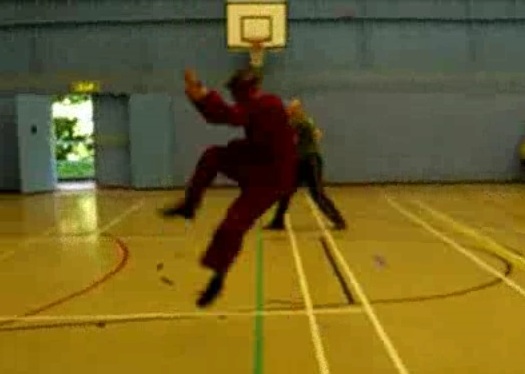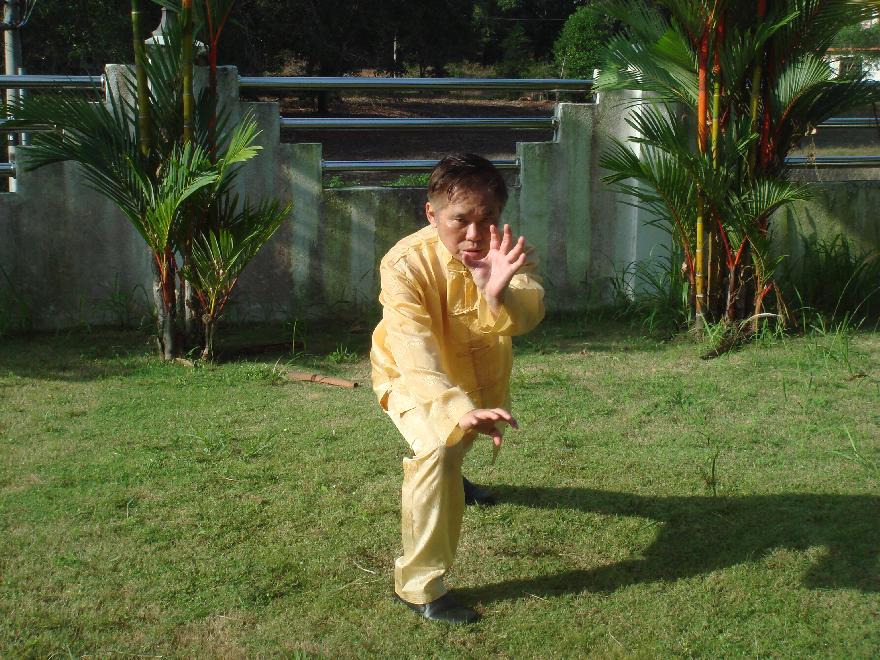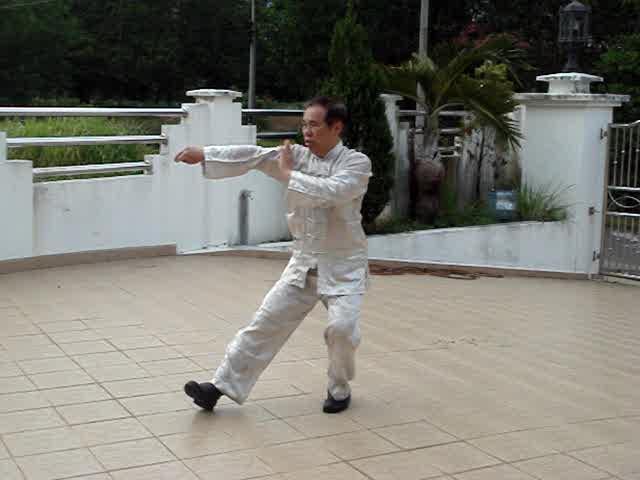NORTHERN SHAOLIN, SOUTHERN SHAOLIN AND PRAYING MANTIS

Northern Shaolin
Question
What are the typical differences between Northern Shaolin Kungfu styles, where Lohan Kungfu was dominant and Southern Shaolin styles?
Could you please elaborate whom the Venerable Chee Seen, Pak Mei and Ng Mui learnt from? Did they learn at the Northern Shaolin Temple?
Why was it that Praying Mantis Kungfu, although very popular and also very effective was no longer officially taught at the Shaolin Temple after some time and replaced by Lohan Kungfu?
Sifu Roland Mastel
Answer
The saying “nan quan bei tui”, or “Southern Fists Northern Kicks”, typically sums up the main difference between Southern Shaolin Kungfu and Northern Shaolin Kungfu. Southern Shaolin styles are well known for fists, whereas Northern Shaolin styles are well known for kicks.
This does not mean that fists are not important in Northern Shaolin styles, or kicks are not important in Southern Shaolin styles. In fact, the hands of Northern Shaolin styliests are often help in fists or open palms. Other hand forms like the tiger claw, the dragon hand, phoenix-eye fist, and the leopard fist which are often found in Southern Shaolin styles, are rarely found in Northern Shaolin styles.
As Chinese is a very concise language, the saying “Southern Fist Northern Kicks” does not limit only to fists and kicks, but has a wider connotation. It implies that Southern Shaolin styles are characterized by stable stances which are conducive to powerful punches, whereas Northern Shaolin styles are characterized by running and jumping which open the way for kicks.
So another typical difference, besides the use of fists and kicks, is that Northern Shaolin styles are agile and involve a lot of wide movement and open space, whereas Southern Shaolin styles are solid with narrower movement and less space. Many commentators mention that this typical difference is due to the availability of wide, open ground in north China, and crowded narrow lanes in the south.
The stances and strikes of Northern Shaolin styles are wider and longer-reach, whereas those of Southern Shaolin styles are narrorer and shorter. In Tantui, for example, both the stance and the arm are stretched far out when executing a punch, whereas in Wing Choon the stance is narrow and the strike is executed in close-quarters.
Another typical difference, though not many people may realize it, is that Northern Shaolin styles mainly use footwork when moving forward to attack or retreating to defend, whereas Southern Shaolin styles tend to use body-movement, often without moving the legs.
When avoiding a powerful punch, for example, a Hoong Ka exponent would sink back his Bow-Arrow Stance, without moving his legs, brush off the punch with one tiger-claw, and immediately shift the body forward, again without moving the legs, and attack the opponent with the other tiger-claw in the pattern “Hungry Tiger Catches Goat”. In avoiding the same powerful punch, a Northern Lohan exponent would move back the front leg of his Bow-Arrow Stance into a T-Step, float the punch with an open palm, and strike the opponent with the other fist in the pattern “Sun Enter Lotus”.
Another typical difference which many people may not realize is that Northern Shaolin styles are relatively simpler, whereas Southern Shaolin styles are more sophisticated. Observers viewing a performance of Northern Shaolin styles can often tell the combat applications of the patterns shown, which are mainly straight-forward punches and kicks. Observers viewing a performance of Southern Shaolin styles may think the patterns merely decorative even when they are effective for combat. Not many people, for example, may know the combat application of “Fierce Tiger Crouching on Ground” of Southern Shaolin.

Southern Shaolin
The Venerable Chee Seen, Pak Mei and Ng Mui learned from the Venerable Chang Mei at the southern Shaolin Temple at Quanzhou before it was burnt down by the Qing army. As Ng Mui was a woman, she might have learned Shaolin Kungfu outside the temple.
It is believed that Ng Mui could be Lui Sai Leong, a great lady kungfu master who single-handedly fought her way into the palace and killed Emperor Yong Cheng to avenge for the burning of the Shaolin Temple. After this, she became a nun, adopted the name Ng Mui, retired from the public and dedicated herself to kungfu and spiritual cultivation.
Like many people, at first I thought that the Venerable Chee Seen, Pak Mei and Ng Mui learned at the northern Shaolin Temple in Henan in the north. This was because it was well known in kungfu circles that after the burning of this Shaolin Temple, Chee Seen built another Shaolin Temple in Fujian in the south, which was also later burnt down by the Qing army.
I was much puzzled because the kungfu practiced and taught by these three Shaolin grandmasters was Southern Shaolin. Had they learned in the northern Shaolin Temple, they would have practiced and taught Northern Shaolin.
This puzzle was solved in my research when I discovered that there were two southern Shaolin Temples, a fact not many people know. One of the two southern Shaolin Temples was in Quanzhou and the other on Nine-Lotus Mountain. Both temples were in Fujian Province, and both were burnt down by the Qing army. The first burning was ordered by Emperor Yong Cheng with help from Lama kungfu experts with their infamous flying guillotines, and the second burning was led by Pak Mei who later sided with the Qing.
The Shaolin Temple in the north remained throughout the Qing Dynasty. It was burnt by rival warlords using guns and cannons 17 years after the overthrow of the Qing Dynasty. Its burning had nothing to do with kungfu. Modern Shaolin monks who claimed lineage to this northern Shaolin Temple probably did not know about this historical fact. They also do not know that this northern Shaolin Temple was long deserted even before its burning. A warlord later used it as a military camp. A rival warlord attacked the camp with guns and cannons.
Although Chee Seen, Pak Mei and Ng Mui learned from the same teacher in the same southern Shaolin Temple in Quanzhou, their kungfu styles were characteristically different. Another Shaolin monk who learned there and escaped from the burning was the Venerable Jiang Nan. His kungfu style was also different.
This was because there was a great variety of kungfu available at the Shaolin Temple, and these grandmasters specialized in different arts. In the same way, 200 years from now, the style of kungfu taught by masters from our Shaolin Wahnam lineage could be characteristically different.
Praying Mantis Kungfu, developed by Wang Lang at the northern Shaolin Temple in Henan, was very effective for combat, and for a time was popularly practiced at the temple. But later it was replaced by Lohan Kungfu, which had been the main style of kungfu at the Shaolin Temple all the while.
This was due to an interesting happening. A Taoist priest, Sheng Shao, was a great Wudang master, but he was a good friend of the abbot of the Shaolin Temple and often visited him.
One day while staying at the Shaolin Temple as a guest he was surprised to see the Shaolin monks practicing an odd style of kungfu very different from Lohan Kungfu, which was normally practiced at the Shaolin Temple. This was Praying Mantis Kungfu developed by Wang Lang at the Temple.
Sheng Xiao was more surprised when he was beaten by these monks using Praying Mantis Kungfu. So during tea time he brought out this topic of the new kungfu in a conversation with his friend, the abbot.
The abbot told Sheng Xiao that he (the abbot) was troubled by this very topic. Praying Mantis Kungfu, he continued, was excellent, but all the while the main style of kungfu taught in the Shaolin Temple was Lohan Kungfu. He did not want to change this age-old tradition, but he also did not want to see Praying Mantis Kungfu discontinued.
The Shaolin monks would revert back to Lohan Kungfu, but the abbot would teach Sheng Xiao all he knew about Praying Mantis Kungfu, and Sheng Xiao would spread it outside the temple. Sheng Xiao learned well and fast, and kept his promise.
The founder of Praying Mantis Kungfu was Wang Lang. The second generation was the unnamed Shaolin monks. Sheng Xiao was the third patriarch. There is an interesting “joke” amongst Praying Mantis practitioners. Praying Mantis Kungfu was invented by a secular master, developed in a Buddhist temple, and spread by a Taoist priest. Of course, as in all kungfu, Praying Mantis Kungfu is non-religious.

Praying Mantis Kungfu
Little Lohan Fist
18-Lohan Fist
Treasure House of Kungfu Sets
Treasure House of Combat Application
Those who wish to attend the 18-Lohan Fist course in Frankfurt, Germany on 26th, 29th, 30th September and 1st October 2014, please contact Secretary, Wahnam Germany or phone (069) 904-31954.
The questions and answers are reproduced from the thread 10 Questions on 18-Lohan Fist in the Shaolin Wahnam Discussion Forum.
LINKS
